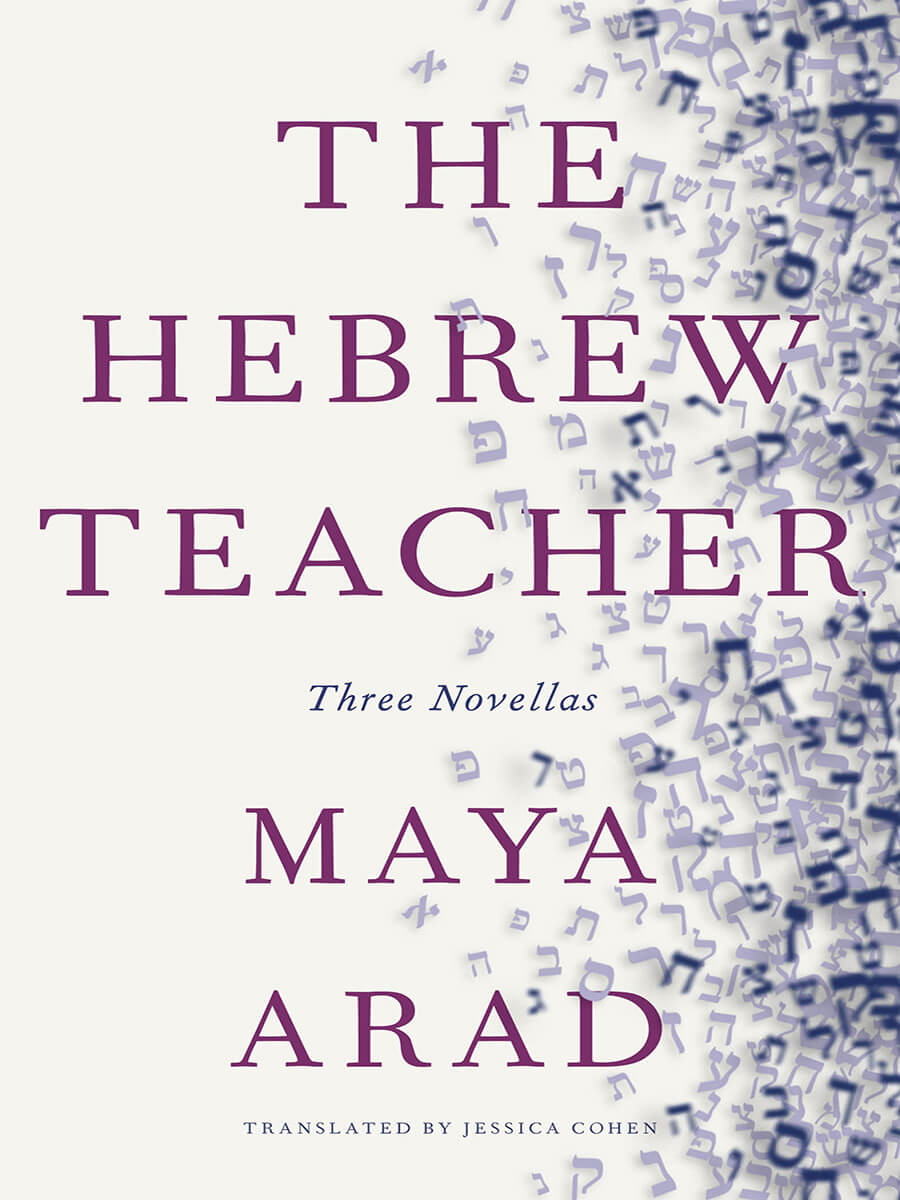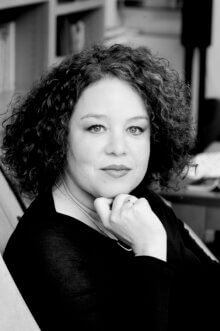
Three Israeli women, their lives altered by immigration to the United States, seek to overcome crises. Ilana is a veteran Hebrew instructor at a Midwestern college who has built her life around her career. When a young Hebrew literature professor joins the faculty, she finds his post-Zionist politics pose a threat to her life’s work. Miriam, whose son left Israel to make his fortune in Silicon Valley, pays an unwanted visit to meet her new grandson and discovers cracks in the family’s perfect façade. Efrat, another Israeli in California, is determined to help her daughter navigate the challenges of middle school, and crosses forbidden lines when she follows her into the minefield of social media. In these three stirring novellas—comedies of manners with an ambitious blend of irony and sensitivity—celebrated Israeli author Maya Arad probes the demise of idealism and the generation gap that her heroines must confront.
Download The Hebrew Teacher Reading Group Guide
Excerpt from The Hebrew Teacher
“It wasn’t a very good time for Hebrew.”
She finished typing the words that had been scurrying around her mind for weeks. She looked at them but felt dissatisfied. Was that right? Was that how you said it?
She tried again: “It was not a very good time for Hebrew.” Now she was confused and couldn’t make up her mind. Which was better? More correct? She’d been living here for almost forty-five years and still could not write a simple sentence in English.
Ilana settled on “It wasn’t a very good time for Hebrew,” but then she stopped writing and shut down the computer. Either way, it was not a good time for Hebrew. When she’d arrived, in ’71, it had been a good time for Hebrew. When she told people she was from Israel, they used to give her admiring looks. The Six-Day War was still fresh in people’s minds. Even the War of Independence still lived in the adults’ memories. And the Yom Kippur War two years after she arrived brought another wave of support. Her classes at the synagogue were packed. Parents wanted their children to be able to chat in Hebrew, not just recite the prayers. There was demand for an adult class, too. Everyone wanted to know a few words before they visited Israel. They wanted to learn the new songs. She remembers singing to them, accompanying herself on the guitar: Od tireh, od tireh—You will yet see, how good it will be, next year . . . They sang along with her, hesitating a little on the verses but joining in for the chorus. At the Jewish day school they begged her to give them a few hours, and within a year she was teaching full-time. Bruce arrived on campus in ’75, and after hearing her praises sung in every possible corner, he asked her to teach a beginners’ Hebrew class at the university.
But now was not a good time for Hebrew. Enrollment had been declining for almost two decades, and had dropped even further in the past three years. Fewer and fewer Jewish students were coming, and those who did were not always interested in learning Hebrew. The situation in Israel wasn’t helping, of course. Israel was a tough sell these days. It wasn’t the fledgling little country of forty-five years ago. Nor was Ilana the same beaming young woman who’d arrived, thick copper braid over one shoulder, to regale the riveted students with stories about hiking from the Mediterranean to the Sea of Galilee, working on a kibbutz, and firing an Uzi when she served in the Israel Defense Forces. They gazed at her admiringly when she told them, “I was born along with the state!” There was boundless pride back then. Pride in the state, pride in herself. Both so young, yet already with such great achievements!
She held up a silver-framed photograph she’d received as a gift from her students: the first graduating Hebrew class at this college. She was still in touch with some of them. Forty years had gone by, and she remembered each and every one: Allen and Sheila, Rachel and Abbie, David and Dave . . . And who was that? Oh yes, Tovi. She’d taught her little sister, too. Ruth. She recognized them all, she thought, smiling to herself as she looked at the group huddled around her, trying to get closer. She was in the middle, radiant, wearing an embroidered blouse and old-fashioned Israeli sandals, looking the same age as them. She could scarcely recognize herself.
When she looked in the mirror in the women’s bathroom, a moment before the first class of the school year, she saw short-cropped, tousled hair, more gray than brown. No trace of copper. Her face was pale and slightly ashen. Gone were the red apple cheeks, which she’d hated so much because they made her look babyish. Her lips were thin, pursed. She wore glasses, and her eyes looked so small behind them. Her eyebrows were practically gone. Night and day between her and the young girl in the embroidered blouse. Night and day between that young country and today’s Israel. Back then, in the good years, she used to organize a big event for Independence Day every year. Israel’s birthday. And hers. There were always colorful poster boards that her students helped make, with pictures and captions: cutting edge agriculture, information technology, unique medical patents, aid to the developing world . . . There were always volunteers to blow up blue-and-white balloons and hang little flags. They’d buy falafel and hummus from the Lebanese restaurant in the next town, and she’d stop by the Jordanian’s grocery store for Bamba and Bissli and other Israeli snacks. They’d set up a table laden with treats on the quad. She would bring the clunky old tape recorder and all her cassettes of beautiful Israeli folk songs: Arik Einstein, Chava Alberstein, Ilanit. In the good years, the Israeli emissary to the campus Hillel House even arranged for a camel—God knows how. They came from all over campus to see it. There were always students who volunteered to staff the table from noon until evening. Everyone who walked by would stop, read the signs, grab a handful of Bamba or a candy bar. Even the ones who didn’t stop waved hello. And there was always a little article in the college newspaper, with a picture of the camel decorated with blue-and-white ribbons.
She hesitated for a moment, then pulled out a tube of subtle brown lipstick and applied it. In a few moments she would walk into her classroom. How many times had she taught Hebrew to beginners? At least forty. How many more times would she do it? However many were needed, she answered herself, and put the lipstick back in her purse. She was irreplaceable. Who could teach Hebrew here, if not her? True, every so often she had some help. The wife of an Israeli grad student who was happy for the part-time work, or a teacher from the Jewish day school looking for extra hours. But everyone knew: Ilana was Hebrew at this college. Without her there was nothing. So many ups and downs she’d been through here. So many changes she’d survived. Transferred from the Language Center to the Center for Jewish Studies, and then to the Middle Eastern Studies program, to which Jewish Studies had been annexed more than a decade ago. Bruce was still the center’s director at the time. He took care of her, made sure her status was unharmed. “What are you worried about, maideleh?” he laughed—he still called her that, even though she was in her fifties—“They can’t get along without you. They’ll always need Hebrew instruction, and how could they get anyone better than you?”
Yes, she’d overcome greater difficulties than this. When Bruce retired, seven years ago, she knew: it wouldn’t be the same without him. She’d almost considered leaving, but he wouldn’t hear of it. “Don’t you dare,” he told her, “we built the Jewish Studies program together. You carry on what we started. I’m here and I’m not going anywhere. You can come to me for advice about anything, even the smallest matter.” She’d believed him. But two years ago his wife, Chana’s, health had deteriorated and they’d moved to assisted living in Chicago, where their oldest son lived. And now, this year, everything had been turned upside down again.
